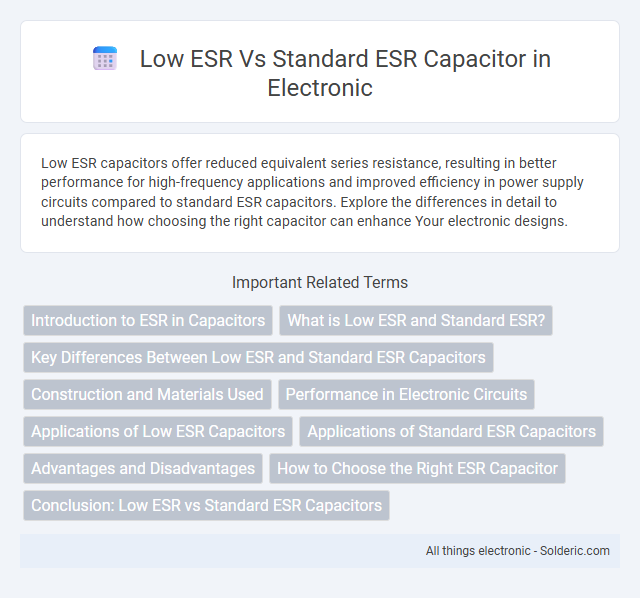Low ESR capacitors offer reduced equivalent series resistance, resulting in better performance for high-frequency applications and improved efficiency in power supply circuits compared to standard ESR capacitors. Explore the differences in detail to understand how choosing the right capacitor can enhance Your electronic designs.
Comparison Table
| Feature | Low ESR Capacitor | Standard ESR Capacitor |
|---|---|---|
| Equivalent Series Resistance (ESR) | Very low (typically < 0.05 O) | Higher (typically 0.1 - 1 O) |
| Heat Dissipation | Efficient, less heat generated | More heat, risk of overheating |
| Performance in High Frequency | Optimized for high-frequency applications | Less efficient at high frequencies |
| Usage | Switching power supplies, RF circuits | General-purpose electronics |
| Cost | Higher cost due to advanced materials | Lower cost, widely available |
| Lifespan | Longer, due to reduced thermal stress | Shorter under high-frequency load |
| Size | Often smaller for same capacitance | Usually larger |
Introduction to ESR in Capacitors
Equivalent Series Resistance (ESR) in capacitors represents the internal resistance that causes power dissipation and affects capacitor performance, especially at high frequencies. Low ESR capacitors are designed with materials and construction techniques that minimize this resistance, resulting in improved efficiency, reduced heat generation, and enhanced reliability in circuits such as power supplies and RF applications. Standard ESR capacitors exhibit higher internal resistance, which may lead to increased energy loss and decreased lifespan under heavy load or high-frequency conditions.
What is Low ESR and Standard ESR?
Low ESR (Equivalent Series Resistance) capacitors have significantly lower internal resistance compared to standard ESR capacitors, enabling faster charge and discharge cycles with minimal energy loss. Standard ESR capacitors typically exhibit higher internal resistance, which can lead to increased heat generation and reduced efficiency in high-frequency or high-current applications. Understanding the difference in ESR values helps you select the appropriate capacitor for optimized circuit performance and longevity.
Key Differences Between Low ESR and Standard ESR Capacitors
Low ESR capacitors feature significantly lower equivalent series resistance, which results in improved efficiency, reduced heat generation, and enhanced performance in high-frequency applications compared to standard ESR capacitors. Standard ESR capacitors typically exhibit higher internal resistance, making them suitable for general-purpose use but less effective in circuits requiring rapid charge-discharge cycles or high ripple current handling. The key difference lies in the construction materials and design, where low ESR capacitors use advanced electrode and electrolyte formulations to minimize resistance and optimize electrical stability.
Construction and Materials Used
Low ESR capacitors feature advanced electrolytes and optimized electrode design that reduce equivalent series resistance, often utilizing polymer or solid electrolytes to enhance conductivity and stability. Standard ESR capacitors commonly use liquid electrolytes and conventional aluminum oxide dielectrics with thicker electrode layers, resulting in higher internal resistance. The choice of materials and construction techniques in low ESR capacitors improves performance in high-frequency and high-current applications compared to standard types.
Performance in Electronic Circuits
Low ESR capacitors offer superior performance in electronic circuits by minimizing equivalent series resistance, which reduces heat generation and improves efficiency during high-frequency switching applications. Standard ESR capacitors may cause voltage drops and energy losses under similar conditions, leading to less stable circuit operation. Choosing a low ESR capacitor enhances your circuit's reliability and ensures better performance in power supply filtering and signal processing tasks.
Applications of Low ESR Capacitors
Low ESR capacitors are ideal for high-frequency switching power supplies, DC-DC converters, and automotive electronics due to their ability to minimize energy losses and reduce heat generation. These capacitors enhance performance in digital systems, LED lighting, and communication equipment by providing stable voltage and efficient power delivery. Your choice of low ESR capacitors ensures improved reliability and longevity in demanding electronic applications.
Applications of Standard ESR Capacitors
Standard ESR capacitors are widely used in general-purpose electronic circuits, including filtering, coupling, and decoupling applications where moderately stable capacitance and ESR values are sufficient. They are commonly found in power supplies, audio equipment, and signal processing devices where cost-effectiveness and reliability take precedence over ultra-low ESR performance. These capacitors function well in circuits that do not require high-frequency stability or minimal impedance under high ripple current conditions.
Advantages and Disadvantages
Low ESR capacitors offer advantages such as reduced equivalent series resistance, leading to improved high-frequency performance and enhanced power efficiency in electronic circuits. They enable better heat dissipation and longer lifespan, making them ideal for applications like power supplies and high-speed digital devices. Standard ESR capacitors are generally more cost-effective but may suffer from increased heat generation and reduced performance in demanding, high-frequency environments.
How to Choose the Right ESR Capacitor
Choosing the right ESR capacitor involves evaluating the application's tolerance for power loss and thermal stability, with low ESR capacitors preferred in high-frequency switching power supplies for their minimal equivalent series resistance and improved heat dissipation. Standard ESR capacitors suit general-purpose applications where cost efficiency outweighs performance sensitivity. Consider factors such as ripple current handling, operating temperature, and longevity to ensure optimal performance and reliability in your electronic circuit design.
Conclusion: Low ESR vs Standard ESR Capacitors
Low ESR capacitors offer significantly lower equivalent series resistance, resulting in better performance in high-frequency, high-ripple current applications compared to standard ESR capacitors. Your choice should depend on the specific requirements of your circuit, such as stability, efficiency, and longevity, where low ESR types excel in reducing heat and improving reliability. Standard ESR capacitors remain suitable for general-purpose use but may fall short in demanding power regulation and filtering scenarios.
Low ESR vs Standard ESR Capacitor Infographic

 solderic.com
solderic.com